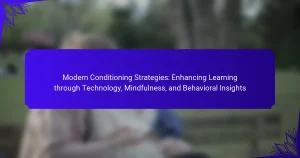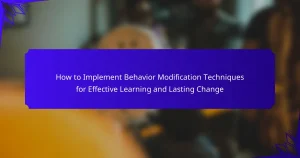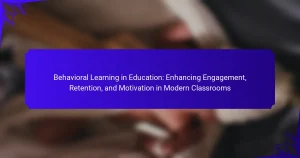Creating a learning environment that enhances engagement, retention, and adaptability is essential for effective education. Focus on interactivity, personalized content, and real-world applications. Incorporate technology and continuous feedback mechanisms to support learner progress. Establish emotional safety and collaborative spaces to foster trust and peer learning.
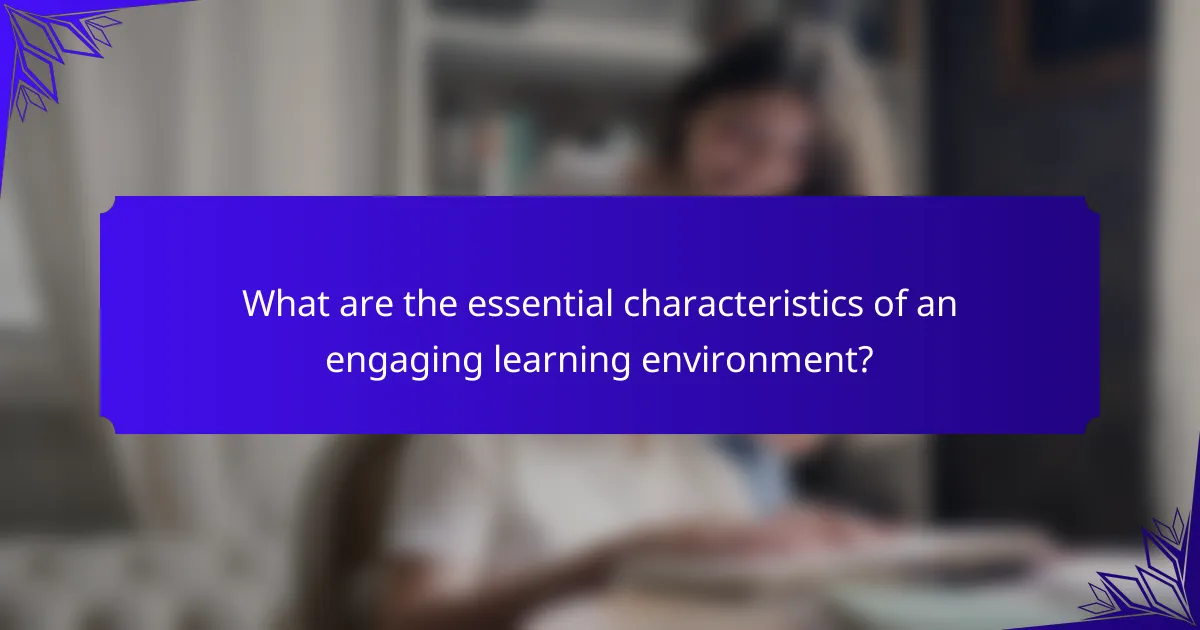
What are the essential characteristics of an engaging learning environment?
An engaging learning environment is characterized by interactivity, flexibility, support, and relevance. Interactivity fosters participation, encouraging learners to actively engage with materials and peers. Flexibility allows for diverse learning styles, accommodating individual preferences. Support from educators and peers enhances motivation and confidence. Relevance connects learning to real-world applications, increasing interest and retention.
How does physical space influence learning engagement?
Physical space significantly influences learning engagement by shaping the environment where learning occurs. Factors such as layout, lighting, and furniture design can enhance or hinder student interaction and focus. Flexible seating arrangements encourage collaboration, while adequate lighting reduces fatigue and improves concentration. Research indicates that well-designed spaces can increase retention rates by up to 25%. Additionally, incorporating elements of nature into learning environments has been shown to enhance creativity and reduce stress, further promoting engagement.
What role does technology play in enhancing retention?
Technology significantly enhances retention by providing interactive and personalized learning experiences. Tools such as adaptive learning platforms tailor content to individual needs, promoting deeper engagement. Additionally, gamification elements can motivate learners, making the retention of information more effective. Data analytics further supports this by identifying knowledge gaps and informing instructional strategies.
How can social interactions boost adaptability in learning?
Social interactions significantly enhance adaptability in learning by fostering collaboration and diverse perspectives. Engaging in discussions and group activities encourages learners to adapt their thinking and approaches. This interaction provides immediate feedback, allowing for quicker adjustments in understanding. Moreover, social environments stimulate motivation and emotional support, which are crucial for resilience in learning. As a result, learners become more flexible in their strategies and problem-solving skills, leading to improved retention and engagement.
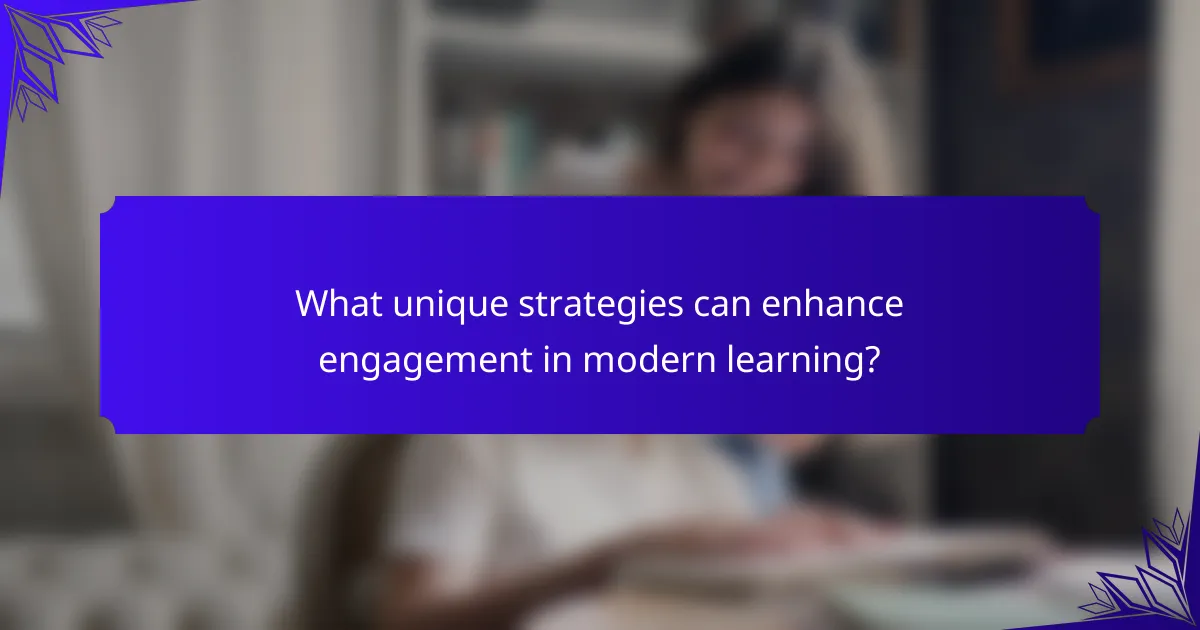
What unique strategies can enhance engagement in modern learning?
To enhance engagement in modern learning, incorporate interactive elements, personalized content, and real-world applications. These strategies foster active participation and deeper understanding.
Interactive elements, such as quizzes and discussions, encourage learners to actively engage with the material. Personalized content, tailored to individual learning styles, increases relevance and motivation. Real-world applications connect theoretical concepts to practical scenarios, enhancing retention and adaptability.
Utilizing technology, such as gamification and virtual reality, can further elevate engagement levels by creating immersive learning experiences. Continuous feedback mechanisms also support learner progress and encourage persistence.
How can gamification be effectively implemented?
Gamification can be effectively implemented by integrating game mechanics into the learning environment. This approach enhances engagement, retention, and adaptability among learners.
First, identify clear learning objectives that align with game elements. For example, incorporating points, levels, and achievements can motivate learners to progress. Second, provide immediate feedback through rewards or recognition, which reinforces positive behavior and encourages persistence. Third, create a sense of community by facilitating collaboration and competition among learners, fostering a supportive atmosphere.
Finally, continuously assess and adapt the gamification strategies based on learner feedback and performance metrics. This iterative process ensures that the learning environment remains dynamic and responsive to the needs of participants.
What are the key elements of successful gamification?
Successful gamification hinges on clear objectives, engaging mechanics, and meaningful feedback. Key elements include defining goals that align with learning outcomes, incorporating game-like features such as rewards and challenges, and ensuring continuous feedback to enhance user motivation. Additionally, adaptability in design allows for personalized experiences that cater to diverse learner needs. These elements collectively foster an interactive learning environment that boosts engagement and retention.
What innovative teaching methods promote active learning?
Innovative teaching methods that promote active learning include project-based learning, flipped classrooms, and collaborative learning. These approaches enhance engagement, retention, and adaptability by encouraging students to take an active role in their education.
Project-based learning immerses students in real-world problems, fostering critical thinking and teamwork. Flipped classrooms allow students to learn at their own pace, engaging with content before class and using class time for interactive discussions. Collaborative learning emphasizes peer interaction, enhancing communication skills and deeper understanding through shared knowledge.
Research shows that these methods significantly improve student outcomes and satisfaction, making them essential for modern educational environments.
How can project-based learning be structured for maximum impact?
To maximize impact, project-based learning should be structured around clear objectives, collaborative activities, and real-world applications. Establishing a supportive environment enhances student engagement and retention.
First, define specific learning outcomes that align with curriculum goals. This clarity helps students understand the purpose of their projects. Next, integrate collaborative group work, promoting communication and teamwork skills. As a result, students learn from diverse perspectives.
Incorporating real-world challenges makes learning relevant and engaging. Projects that address community issues or industry problems increase motivation and adaptability. Finally, provide ongoing feedback and reflection opportunities, allowing students to assess their progress and adapt their approaches.

What rare attributes contribute to a highly effective learning environment?
A highly effective learning environment is characterized by rare attributes such as emotional safety, personalized feedback, and collaborative spaces. Emotional safety fosters trust, encouraging students to take risks without fear of judgment. Personalized feedback enhances engagement by addressing individual learning needs. Collaborative spaces facilitate interaction, promoting peer learning and adaptability. These attributes create a dynamic atmosphere that significantly improves retention and engagement.
How does cultural relevance affect student engagement?
Cultural relevance significantly enhances student engagement by making learning more relatable. When students see their own cultures reflected in the curriculum, they feel valued and understood. This connection fosters a sense of belonging, which is crucial for motivation and participation.
Moreover, culturally relevant teaching practices can improve retention rates. For instance, integrating local histories or familiar contexts into lessons can help students grasp complex concepts more easily. As a result, they are more likely to retain information and apply it in real-world situations.
Additionally, cultural relevance promotes adaptability in learning environments. Educators who incorporate diverse perspectives are better equipped to address the varied needs of their students. This approach not only enriches classroom discussions but also prepares students for a multicultural world.
In summary, cultural relevance is a powerful tool for enhancing engagement, retention, and adaptability in educational settings.
What unconventional approaches have proven successful in diverse settings?
Innovative strategies like project-based learning and gamification have successfully enhanced engagement in diverse educational settings. These approaches foster collaboration, creativity, and critical thinking. Project-based learning encourages students to work on real-world problems, promoting deeper understanding and retention. Gamification incorporates game elements to motivate learners, resulting in higher participation rates. Schools implementing these methods report improved adaptability among students, as they learn to navigate challenges effectively.
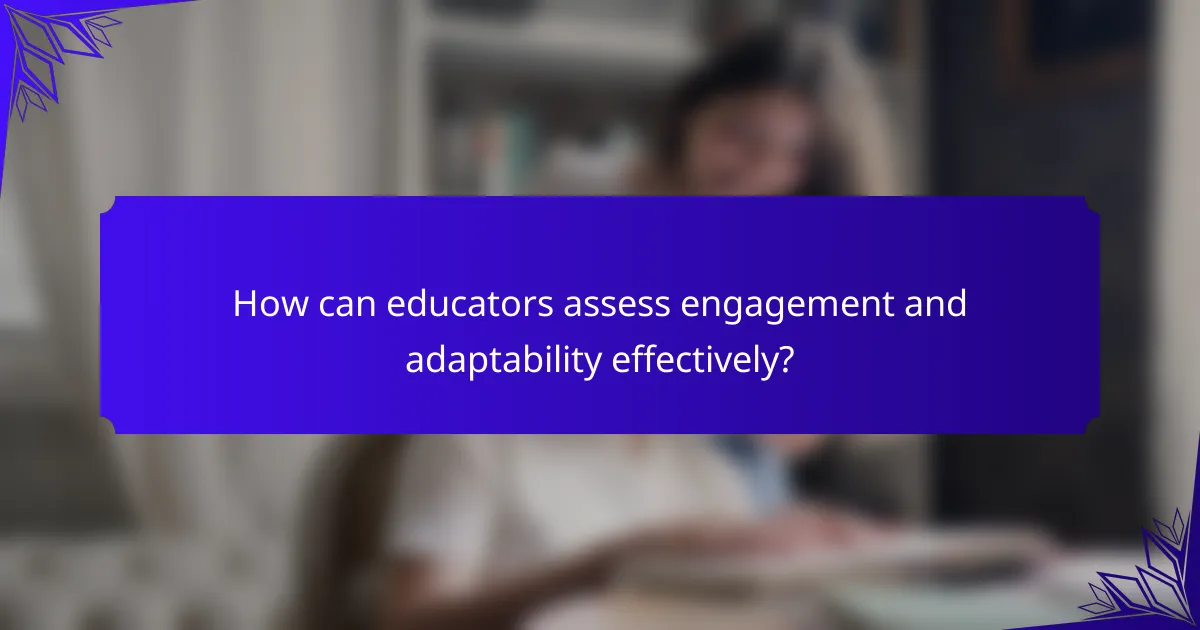
How can educators assess engagement and adaptability effectively?
Educators can assess engagement and adaptability by utilizing diverse assessment methods. Observations, surveys, and performance metrics provide insights into student participation levels and flexibility in learning approaches. Incorporating formative assessments allows for real-time feedback, enabling educators to adjust teaching strategies effectively. Additionally, leveraging technology tools can enhance data collection and analysis, revealing trends in student engagement.
What metrics should be used to evaluate learning retention?
To evaluate learning retention, use metrics such as recall tests, application assessments, and engagement levels. These metrics measure how well learners can remember and apply knowledge over time.
| Metric | Description |
|—————————-|———————————————————|
| Recall Tests | Measure the ability to retrieve information from memory. |
| Application Assessments | Evaluate how knowledge is used in practical scenarios. |
| Engagement Levels | Analyze interaction and participation in learning activities. |
| Longitudinal Studies | Track retention over extended periods to assess knowledge retention. |
| Feedback Surveys | Gather learner insights on their perceived retention and understanding. |
| Performance Metrics | Assess improvements in skills or knowledge through pre- and post-tests. |
How can feedback loops improve the learning process?
Feedback loops significantly enhance the learning process by providing continuous improvement. They allow learners to receive timely input on their performance, fostering adaptability and engagement. Regular feedback helps identify strengths and weaknesses, enabling targeted adjustments in learning strategies. This iterative process enhances retention by reinforcing knowledge and skills. Furthermore, it cultivates a growth mindset, encouraging learners to embrace challenges and persist through difficulties. Overall, feedback loops create a dynamic learning environment that supports ongoing development and mastery of content.

What best practices can be adopted for creating a lasting impact?
To create a lasting impact, adopt best practices that foster engagement, retention, and adaptability in learning environments. Prioritize active learning techniques, such as collaborative projects and discussions, to deepen understanding. Incorporate technology and multimedia resources to cater to diverse learning styles. Regular feedback loops enhance retention by reinforcing key concepts. Establish a supportive culture that encourages risk-taking and adaptability in learners.
What common mistakes should be avoided in learning environment design?
To create an effective learning environment, avoid mistakes that hinder engagement and adaptability. Common errors include neglecting diverse learning styles, overcrowding spaces with distractions, failing to incorporate technology, and overlooking feedback mechanisms. Each of these factors can significantly impact retention and overall effectiveness.
How can continuous improvement be integrated into learning strategies?
Integrating continuous improvement into learning strategies enhances engagement and adaptability. Regular feedback loops, data analysis, and iterative revisions foster a culture of growth. Establishing clear metrics for success allows for targeted adjustments, ensuring that learning methods evolve based on participant needs and outcomes. Emphasizing collaboration among learners encourages diverse perspectives, which can drive innovative approaches to problem-solving.
What expert insights can guide the development of engaging learning environments?
Creating engaging learning environments requires expert insights that focus on interaction, flexibility, and inclusivity. Incorporating active learning strategies enhances student participation and retention. Research indicates that environments fostering collaboration lead to improved outcomes, with studies showing a 30% increase in engagement when students work in groups. Additionally, utilizing technology for personalized learning allows adaptability to individual needs, enhancing the overall educational experience. Finally, a supportive atmosphere that encourages feedback and open communication can significantly boost motivation and learning effectiveness.
